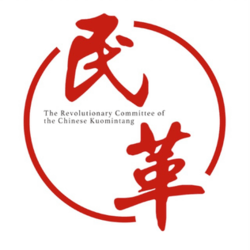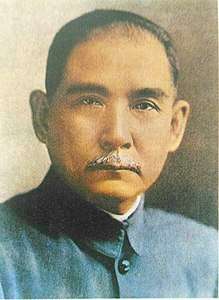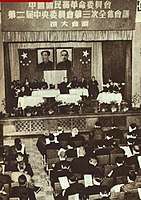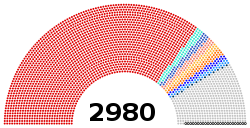Revolutionary Committee of the Chinese Kuomintang
The Revolutionary Committee of the Chinese Kuomintang (abbreviated RCCK) is one of eight registered minor political parties (in addition to the Communist Party of China) in the People's Republic of China.
Revolutionary Committee of the Chinese Kuomintang 中国国民党革命委员会 Zhōngguó Guómíndǎng Gémìng Wěiyuánhuì | |
|---|---|
 | |
| Abbreviation | RCCK |
| Chairperson | Wan Exiang |
| Founded | 1 January 1948 |
| Split from | Kuomintang |
| Preceded by | Left wing of the Kuomintang |
| Headquarters | Beijing, China |
| Newspaper | Tuanjie Bao (Solidarity/Unity Daily)[1] Tuanjie (Unity) |
| Membership (2017) | 131,410[2] |
| Ideology | Three Principles of the People Socialism with Chinese characteristics Chinese unification Chinese nationalism Xi Jinping Thought[3][4] |
| Political position | Left-wing |
| National affiliation | United Front |
| National People's Congress | 43 / 2,980 |
| NPC Standing Committee | 6 / 175 |
| Election symbol | |
 | |
| Website | |
| Official website | |
| Revolutionary Committee of the Chinese Kuomintang | |||||||||||||
|---|---|---|---|---|---|---|---|---|---|---|---|---|---|
| Chinese name | |||||||||||||
| Simplified Chinese | 中国国民党革命委员会 | ||||||||||||
| Traditional Chinese | 中國國民黨革命委員會 | ||||||||||||
| Literal meaning | "Revolutionary Committee of the Nationalist Party of China" | ||||||||||||
| |||||||||||||
| Abbreviation | |||||||||||||
| Chinese | 民革 | ||||||||||||
| |||||||||||||
| Tibetan name | |||||||||||||
| Tibetan | ཀྲུང་གོ་གོ་མིན་ཏང་གསར་བརྗེ་ཨུ་ཡོན་ལྷན་ཁང | ||||||||||||
| |||||||||||||
| Zhuang name | |||||||||||||
| Zhuang | Cunghgoz Gozminzdangj Gwzming Veijyenzvei | ||||||||||||
| Mongolian name | |||||||||||||
| Mongolian Cyrillic | Дундад улсын гоминдангийн хувьсгалын зөвлөл | ||||||||||||
| Mongolian script | ᠳᠤᠮᠳᠠᠳᠤ ᠤᠯᠤᠰ ᠤᠨ ᠭᠣᠮᠢᠨᠳᠠᠩ ᠤᠨ ᠬᠤᠪᠢᠰᠬᠠᠯ ᠤᠨ ᠵᠥᠪᠯᠡᠯ | ||||||||||||
| Uyghur name | |||||||||||||
| Uyghur | جۇڭگو گومىنداڭ ئىنقىلابىي كومىتېتى | ||||||||||||
| |||||||||||||
| Manchu name | |||||||||||||
| Manchu script | ᠮᡳᠨᡬᡝ | ||||||||||||
| Romanization | Ming'e | ||||||||||||
It was founded in 1948 by left-wing members who broke with the main Kuomintang (KMT) during the Chinese Civil War, especially those who were against Chiang Kai-shek's policies. The party claims to be the true heir of Sun Yat-sen's legacy. By the end of 2017, it had 131,410 members.[2]
Its honorary chairperson Song Qingling served as Vice President of the People's Republic of China and Honorary President of the People's Republic of China. The chairperson Li Jishen served as vice chairman of the Central People's Government.
Among the officially sanctioned political parties of the People's Republic of China, the Revolutionary Committee is seen as second in status to the Communist Party of China. Thus, the Revolutionary Committee is allotted the second highest number of seats in the People's Political Consultative Conference (30%). It also owns numerous assets, some formerly owned by the Kuomintang, throughout mainland China. The Revolutionary Committee operates a range of party-owned institutions, such as party schools.
History
After World War II, the relationship between the Kuomintang and the Communist Party of China became increasingly tense, and the resumption of the Chinese Civil War was imminent. In 1945 and 1946, the left-wing members of the Kuomintang founded the Sanminzhuyi Comrades Association and the Chinese Kuomintang Democratic Promotion Association in Chongqing and Guangzhou respectively, with the "leftists" gradually separating from the right-wing Kuomintang.
The first joint representative meeting of the left-wing Kuomintang was held in Hong Kong in November 1947, and on January 1, 1948, the Revolutionary Committee of the Chinese Kuomintang was formally inaugurated with Soong Ching-ling, the widow of Sun Yat-sen, as its honorary chairman.
Central Committee leaders
Chairpersons of the Central Committee
- Li Jishen (李济深) (1948–1959)
- He Xiangning (何香凝) (1960–1972)
- Zhu Yunshan (朱蕴山) (1979–1981)
- Wang Kunlun (王昆仑) (1981–1985)
- Qu Wu (屈武) (1987–1988)
- Zhu Xuefan (朱学范) (1988–1992)
- Li Peiyao (李沛瑶) (1992–1996)
- He Luli (何鲁丽) (1996–2007)
- Zhou Tienong (周铁农) (2007–2012)
- Wan Exiang (万鄂湘) (2012–present)[5]
Honorary Chairpersons of the Central Committee
- Song Qingling (宋庆龄) (1948–1949)
- Qu Wu (屈武) (1988–1992)
- Zhu Xuefan (朱学范) (1992–1996)
- Hou Jingru (侯镜如) (1992–1994)
- Sun Yueqi (孙越崎) (1992–1995)
Regional committee leaders
Chairpersons of provincial committees
- Han Youwen – Chairman of the Xinjiang Branch[6][7]
Electoral history
National People's Congress elections
| Election year | Number of seats |
|---|---|
| 2017–18 | 43 / 2,970 |
Gallery
 RCCK uses portraits of Sun Yat-sen instead of the traditional symbol of Blue Sky with White Sun.[8]
RCCK uses portraits of Sun Yat-sen instead of the traditional symbol of Blue Sky with White Sun.[8] The Third Session of the Second Central Committee of the Revolutionary Committee of the Chinese Kuomintang in March 1953.
The Third Session of the Second Central Committee of the Revolutionary Committee of the Chinese Kuomintang in March 1953.
See also
References
- "Archived copy" 团结报数字报 (in Chinese). Archived from the original on 2018-01-11. Retrieved 2018-01-11.CS1 maint: archived copy as title (link)
- "Archived copy" 中国国民党革命委员会简介. Minge.gov.cn (in Chinese). 2018-04-09. Archived from the original on 2019-05-26. Retrieved 2019-03-08.CS1 maint: archived copy as title (link)
- "Archived copy" 民革第十三次全国代表大会暨民革成立70周年纪念大会在京开幕 王沪宁代表中共中央致贺词-人民资讯-人民网. Minge.gov.cn (in Chinese). 2017-12-20. Archived from the original on 2019-07-13. Retrieved 2018-01-11.CS1 maint: archived copy as title (link)
- "Archived copy" 中国国民党革命委员会章程(2017年12月23日)-人民资讯-人民网. Minge.gov.cn (in Chinese). 2017-12-23. Archived from the original on 2019-07-12. Retrieved 2018-01-11.CS1 maint: archived copy as title (link)
- "Archived copy" 民革中央领导简介(包括现任领导、历届领导)-人民资讯-人民网. Minge.gov.cn (in Chinese). 2017-12-24. Archived from the original on 2017-12-22. Retrieved 2018-01-11.CS1 maint: archived copy as title (link)
- United States. Joint Publications Research Service (1985). China report: political, sociological and military affairs, Issues 19-24. Foreign Broadcast Information Service. p. 103. Retrieved 2011-04-03.
- 《中国人名大辞典》编辑部 (1994). Who's who in China current leaders. Foreign Languages Press. p. 185. ISBN 7-119-00725-4. Retrieved 2011-04-03.
- Chinese KMT Revolutionary Committee holds national congress Archived 2018-03-05 at the Wayback Machine. Retrieved 2018-03-05.

